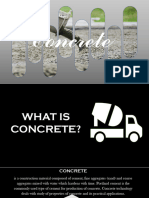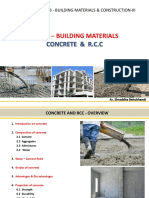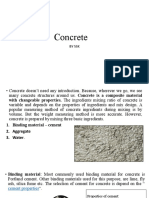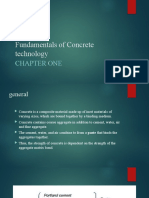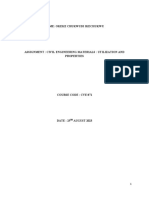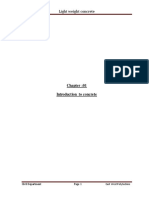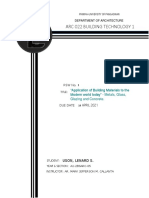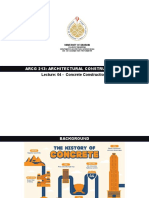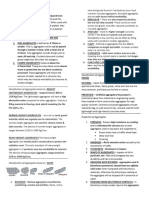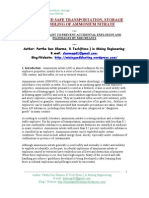0 ratings0% found this document useful (0 votes)
9 viewsCONCRETE
Concrete is a construction material composed of cement, fine
aggregates (sand) and coarse aggregates mixed with water which
hardens with time.
Uploaded by
Marielle MargaritoCopyright
© © All Rights Reserved
We take content rights seriously. If you suspect this is your content, claim it here.
Available Formats
Download as PDF, TXT or read online on Scribd
0 ratings0% found this document useful (0 votes)
9 viewsCONCRETE
Concrete is a construction material composed of cement, fine
aggregates (sand) and coarse aggregates mixed with water which
hardens with time.
Uploaded by
Marielle MargaritoCopyright
© © All Rights Reserved
We take content rights seriously. If you suspect this is your content, claim it here.
Available Formats
Download as PDF, TXT or read online on Scribd
You are on page 1/ 2
GROUP 9 – CONRETE used in the construction of atomic power plants and for
similar projects. The heavy weight aggregate will help the
CONCRETE - is a construction material composed of cement, fine structure to resist all possible type of radiations.
aggregates (sand) and coarse aggregates mixed with water which 6. Polymer Concrete - When compared with the conventional
hardens with time. Portland cement is the commonly used type of concrete, in polymer concrete the aggregates will be bound
cement for production of concrete. Concrete technology deals with with the polymer instead of cement. The production of
study of properties of concrete and its practical applications. In a polymer concrete will help in the reduction of volume of
building construction, concrete is used for the construction of voids in the aggregate. This will hence reduce the amount
foundations, columns, beams, slabs and other load bearing of polymer that is necessary to bind the aggregates used.
elements. There are different types of binding material is used 7. Asphalt Concrete - Asphalt concrete is a composite
other than cement such as lime for lime concrete and bitumen for material, mixture of aggregates and asphalts commonly
asphalt concrete which is used for road construction. used to surface roads, parking lots, airports, as well as the
core of embankment dams. Asphalt concrete is also called
Concrete - is used to provide strength, durability, and versatility
during the construction of a structure. These excellent properties as asphalt, blacktop or pavement in North America, and
have made concrete a reliable and long-lasting choice of tarmac or bitumen macadam or rolled asphalt in the
construction companies for both commercial and domestic types of United Kingdom and the Republic of Ireland.
8. Asphalt Concrete - Asphalt concrete is a composite
constructions.
material, mixture of aggregates and asphalts commonly
HOW TO SELECT CONCRETE FOR GIVEN APPLICATIONS? used to surface roads, parking lots, airports, as well as the
1. Normal Strength Concrete - The concrete that is obtained core of embankment dams. Asphalt concrete is also called
by mixing the basic ingredients cement, water and as asphalt, blacktop or pavement in North America, and
aggregate will give us normal strength concrete. The tarmac or bitumen macadam or rolled asphalt in the
strength of these type of concrete will vary from 10 MPa to United Kingdom and the Republic of Ireland.
40MPa. The normal strength concrete has an initial setting
time of 30 to 90 minutes that is dependent on the cement ENGINEERING PROPERTIES OF CONCRETE
1. Workability of Concrete - Workability of Concrete is a term
properties and the weather conditions of the construction
describing how easily freshly mixed concrete can be mixed,
site.
placed, consolidated, and finished with minimal loss of
2. Plain Concrete - The plain concrete will have no
homogeneity. Workability is a property that directly
reinforcement in it. The main constituents are the cement,
impacts strength, quality, appearance, and even the cost of
aggregates, and water. Most commonly used mix design is
1:2:4 which is the normal mix design . The density of the labor for placement and finishing operations.
2. Segregation of concrete - Separation of coarse aggregate
plain concrete will vary between 2200 and 2500 Kg/meter
cube. The compressive strength is 200 to 500 kg/cm2. from the concrete mix is called Segregation of concrete. A
3. Reinforced Concrete - The reinforced cement concrete is good concrete should show no to less segregation after
defined as the concrete to which reinforcement is mixing. Excessive segregation leads to honeycombing and
introduced to bear the tensile strength. Plain concrete is decreasing in the density of concrete and ultimately loss of
weak in tension and good in compression. Hence the strength of hardened concrete.
placement of reinforcement will take up the responsibility 3. Bleeding in Concrete - Bleeding in concrete is a
of bearing the tensile stresses. R.C.C works. phenomenon in which free water in the mix rises up to the
4. Lightweight Concrete - Concrete that have a density lesser surface and forms a paste of cement on the surface known
than 1920kg/m3 will be categorized as lightweight as “laitance”. Bleeding occurs in concrete when coarse
aggregates tends to settle down and free water rises up to
concrete. The use of lightweight aggregates in concrete
design will give us lightweight aggregates. Aggregates are the surface. Bleeding makes concrete porous and weak.
the important element that contributes to the density of Properties of concrete during its hardened stage:
the concrete. The examples of light weight aggregates are 1. Compressive Strength / Concrete grades - is defined as
the pumice, perlites, and scoria. that level of strength below which a specified proportion of
5. High-Density Concrete - The concretes that have densities all valid test results is expected to fail. Unless otherwise
ranging between 3000 to 4000 kg/m3 can be called as the stated, this proportion is taken to be 5.
heavyweight concrete. Here heavy weight aggregates are 2. Tensile strength of concrete - is an important property
used . The crushed rocks are used as the coarse aggregates. which affects the extent & width of cracks in the structure.
The most commonly used heavy weight aggregates is A good concrete should have a tensile strength of 1/10
Barytes. These types of aggregates are most commonly times that of compressive strength.
3. Modulus of elasticity - Elasticity modulus of concrete is an a. Rapid Chloride Permeability Test (RCPT) - The
important property required for computation of rapid chloride permeability test is a test to
deflections of structural concrete members. Modulus of determine the concrete’s ability to resist the
elasticity is the ratio between Stress and Strain. Physically it penetration of chloride ions in it. Chloride ions are
indicates a material’s resistance to being deformed when passed through the sample of concrete electrically.
stress is applied to it. b. Water Permeability Test By Pressure - also known
4. Durability - is the property of concrete to withstand the as water penetration test, is generally performed
condition for which it has been designed, without to measure the permeability of concrete, having
deterioration over a period of years. Lack of durability can high permeability .In this test, water with pressure
be caused by external agents arising from the environment is continuously passed through a disc-shaped
or by internal agents within the concrete concrete sample for a fixed time interval.
5. Impermeability - The impermeability of concrete refers to c. Drying Shrinkage Test - The procedure for
the property of concrete that cannot be pervaded by determining the drying shrinkage or change in
water, oil and other liquids with pressures. It plays an length of concrete specimen due to changes in
important role in the durability of concrete. Moreover, it moisture content. This test method is used to
also directly affects the frost-resistance and anti-corrosion provide documentation that a given concrete
of concrete. mixture will meet a specified shrinkage limit.
6. Poisson ratio - is the ratio of transverse contraction strain 4. MODULUS OF ELASTICITY TEST - Also known as elastic
to longitudinal extension strain in the direction of modulus, the coefficient of elasticity of material is a
stretching force. Poisson's ratio measures the deformation number that is defined by the ratio of the applied stress to
in the material in a direction perpendicular to the direction the corresponding strain within the elastic limit. Physically
of the applied force. it indicates a material’s resistance to being deformed when
stress is applied to it. Modulus of elasticity also indicates
Civil engineering uses of concrete the stiffness of a material. . The value of elastic modulus is
1. Concrete Dams higher for stiffer materials.
2. Residential Buildings
3. Commercial Buildings
4. Roads or Driveways
5. Marine Construction
6. Culverts and Sewers
7. Foundations
8. Fences
9. Concrete Bridge
TYPES OF TEST IN CONCRETE
1. COMPRESSIVE STRENGTH TEST - Compressive strength is
measured by breaking cylindrical concrete specimens in a
compression-testing machine. Compressive strength is
calculated from the failure load divided by the cross-
sectional area resisting the load and reported in units of
pound-force per square inch (psi) or megapascals (MPa).
2. SLUMP TEST - It is the most simple workability test for
concrete, involves low cost and provides immediate
results. Due to this fact, it has been widely used for
workability tests since 1922. The slump is carried out as per
procedures mentioned in ASTM C143 in the United States,
IS: 1199 – 1959 in India and EN 12350-2 in Europe.
3. PERMEABILITY TEST - Permeability tests are important
especially for Reinforced Cement Concrete (RCC) as the
reinforcement bars present inside the concrete element
are prone to corrosion when in contact with water. Due to
corrosion, the volume of concrete expands and leads to
cracking of the concrete element.
You might also like
- Concrete: According To Binding MaterialNo ratings yetConcrete: According To Binding Material16 pages
- Subject:: "Building Materials & Construction"No ratings yetSubject:: "Building Materials & Construction"42 pages
- Chapter 1: Introduction: What Is ConcreteNo ratings yetChapter 1: Introduction: What Is Concrete7 pages
- Cen 204 Module 5a Concrete Concrete PropertiesNo ratings yetCen 204 Module 5a Concrete Concrete Properties145 pages
- Concrete: Classification, Properties, Types and TestingNo ratings yetConcrete: Classification, Properties, Types and Testing35 pages
- REVISED Concrete Technology BOOK - by Sri P. SURESH100% (1)REVISED Concrete Technology BOOK - by Sri P. SURESH63 pages
- Chapter 1 Fundamentals Concrete TechnologyNo ratings yetChapter 1 Fundamentals Concrete Technology50 pages
- Concrete Concrete: It Is An Artificial Stone Manufacturing From A Mixture of BindingNo ratings yetConcrete Concrete: It Is An Artificial Stone Manufacturing From A Mixture of Binding22 pages
- Tle1-Introduction To Industrial Arts - MasonryNo ratings yetTle1-Introduction To Industrial Arts - Masonry52 pages
- Introduction To Reinforced Conrete: Prepared By: Engr. Christopher E. RodolfoNo ratings yetIntroduction To Reinforced Conrete: Prepared By: Engr. Christopher E. Rodolfo35 pages
- Arc 022 Building Technology 1: Department of ArchitectureNo ratings yetArc 022 Building Technology 1: Department of Architecture19 pages
- Arcg 213: Architectural Construction - INo ratings yetArcg 213: Architectural Construction - I23 pages
- Principles of Reinforced Concrete - IntroductionNo ratings yetPrinciples of Reinforced Concrete - Introduction14 pages
- Road to Excellence Advanced Concepts in Highway Engineering (Part-3)From EverandRoad to Excellence Advanced Concepts in Highway Engineering (Part-3)No ratings yet
- Sakit Akon Tiyan Kada Mag Ubo-Ubo Ko.": Predisposing Factors: Precipitating FactorsNo ratings yetSakit Akon Tiyan Kada Mag Ubo-Ubo Ko.": Predisposing Factors: Precipitating Factors4 pages
- UrbanMed - A Mobile Application For Online PharmacyNo ratings yetUrbanMed - A Mobile Application For Online Pharmacy7 pages
- Proficy Hmi/Scada - Ifix: Mportant Product NformationNo ratings yetProficy Hmi/Scada - Ifix: Mportant Product Nformation47 pages
- Secured and Safe Transportation, Storage and Handling of Ammonium NitrateNo ratings yetSecured and Safe Transportation, Storage and Handling of Ammonium Nitrate11 pages
- Transformer Room Ventilation Calculation 20170310xlsx - CompressNo ratings yetTransformer Room Ventilation Calculation 20170310xlsx - Compress1 page
- Tattoos As Subcultureal Style, Commodity and Self-ExpressionNo ratings yetTattoos As Subcultureal Style, Commodity and Self-Expression37 pages
- Techno Commercial Document: Rashid Petroleum COMPANYNo ratings yetTechno Commercial Document: Rashid Petroleum COMPANY22 pages
- Shop Safety Rules and Practices Tve 7 ModuleNo ratings yetShop Safety Rules and Practices Tve 7 Module13 pages
- 2020 - Corporate Governance and Corporate Social Responsibility Disclosure Quality in Indonesian CompaniesNo ratings yet2020 - Corporate Governance and Corporate Social Responsibility Disclosure Quality in Indonesian Companies22 pages
- Порівняння SUN2000-30KTL-M3 VS Solis 30K-5GNo ratings yetПорівняння SUN2000-30KTL-M3 VS Solis 30K-5G8 pages




